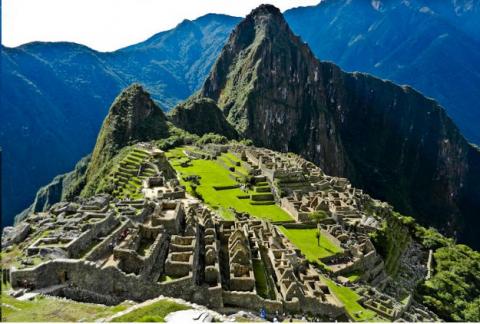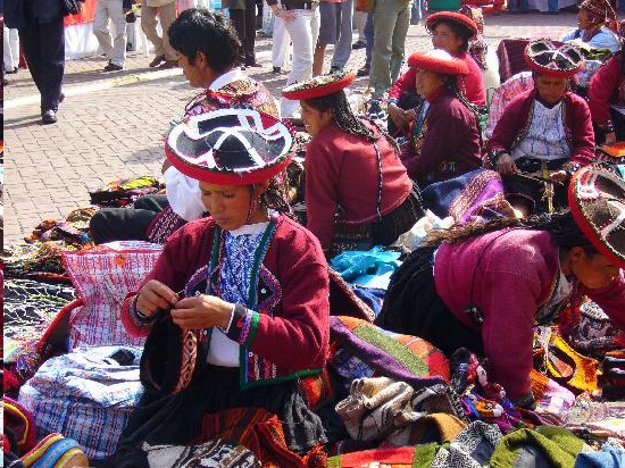Time-Traveling in Peru: A Journey to Machu Picchu

For people with a desire to travel back in time, watching a movie or reading a novel may be the closest they will ever get to fulfilling their dream. For those with a broader imagination, however, there are other ways to travel through time that do not involve building a time machine—visiting a place that has remained virtually untouched by man since it was first created, giving the impression that it might indeed be frozen in time, appearing exactly the same today as it did hundreds of years ago, may in fact simulate the feeling of travelling to the past.
While it may not be the same as the commonly accepted notion of time travel, taking a moment to contemplate and visualize the past when fortunate enough to visit one of these places can be just as good. One such place is the UNESCO World Heritage Site known as Machu Picchu, located deep in the mountains of southern Peru. Several hundred years old, Macchu Picchu was only “discovered” (or rediscovered, as it were) a little over a century ago. Getting there is a journey in itself, one that usually begins for international travelers in Lima, Peru’s capital city.
The largest city in Peru, Lima is the gateway for those visiting the country, and while it is distinctively Peruvian in culture and history, it is also extremely unique and vastly different from the rest of Peru. Situated on the country’s coastal border with the Pacific Ocean, Lima begins at sea level and despite a rise in elevation as it progresses inland, it never quite reaches the same heights as the rest of Peru, known primarily for mountainous regions that sit at high altitudes. Lima’s climate is considered to be that of a mild desert—neither too hot nor too cold—but very dry, with the average rainfall in the city being a scant four millimeters per year. Despite this, proximity to the ocean does make for persistent humid conditions, with fog and clouds very common, making Lima one of the least sunny cities in the region. As a result, Lima is an ideal place to visit virtually any time of year, and its popularity among tourists from all over the world reflects that.
Lima enjoys a rich history, including settlements by what are known as pre-Incan civilizations. Archeological sites built by some of these groups have recently been unearthed among Lima’s more contemporary buildings, including one called Huaca Pucllana, which sits squarely within the trendy Miraflores neighborhood. Additionally, there are many historic churches to be found around Lima which illustrate the prominent presence of religion among Peruvians not only today, but throughout a somewhat tumultuous past. Within these churches, there is much information dedicated to the history of San Martin de Porres and Santa Rosa of Lima, two of the most famous Catholic saints with Peruvian backgrounds.
In Lima, history is consistently complimented by culture, with world-class nightlife and dining found in the neighborhoods of Miraflores and Barranco, as well as in other areas, making Lima a city with diverse offerings and much to keep a visitor occupied. While it is not perfect, with many parts of the city undesirable for outsiders, Lima is a city filled with mostly friendly and welcoming citizens, making it a place travelers should add to their list if it is not already there.

The journey back in time continues with a short 90 minute flight from Lima to the city of Cusco. Sitting at an elevation of 11,152 feet above sea level, the assault on the senses by this ancient Incan settlement in the heart of the Andes Mountains begins almost immediately, with those not acclimated prone to symptoms of altitude sickness, including nausea, vomiting, headaches, and light-headedness. It is recommended that travelers take at least two days to adjust to the thinner air before beginning the trek to Machu Picchu, an excellent suggestion which provides ample time to explore this fascinating city, itself appearing to be somewhat frozen in time. A city of hills and valleys, a stroll through the streets of Cusco is usually one of two things: extreme uphill or downhill. Fortunately there is enough to see to distract from the shortness of breath that is bound to happen frequently, including its recognizable pre-Colombian and colonial architecture, a feature that prompted UNESCO to declare Cusco a World Heritage Site in 1983.
The central meeting point and perfect starting point for exploration of Cusco is the Plaza de Armas, the scene of many important events in history, including the execution of Tupac Amaru II, the leader of the resistance of the conquest of the Incas by Spain. Surrounded by many historic buildings—including the Iglesia de la Compania de Jesus, a church dating back to 1576—as well as many shops and restaurants, the main sites of Cusco are all within a short walking distance of this important square.
One of these attractions is Qurikancha and the Convent of Santo Domingo, considered by many to be one of the most important destinations for the study of the Incas, featuring a temple to worship the Incan Sun God and stone walls with a similar construction to those found at Machu Picchu. Additionally, a stroll through the mostly cobblestone streets will take travelers to sites such as the Museo Inka and the Mercado de San Pedro, where it is possible to buy various souvenirs while also having an inexpensive meal of traditional Peruvian food prepared on site by locals. Never has recovering from altitude sickness been so much fun.

As Cusco is the closest major city with an airport to Machu Picchu, all journeys to the famous site begin here. Contrary to popular belief, however, Machu Picchu is not in Cusco—even making a trip directly from one to the other without stopping (a mistake, as there is much to see along the way) takes several hours consisting of varying modes of transportation. What many travelers fail to realize is that this entire region in southern Peru made up the majority of the Incan Empire, and as a result there are many important historic sites that visitors should make sure to see before arriving at Machu Picchu, without which any trip there would be incomplete.
These sites include Pisac, famous for its market and remnants of agricultural terraces constructed by the Incas, as well as Choquequirao, another less famous site of Incan ruins which, while not usually included in Machu Picchu tour itineraries, is a fantastic stop that attracts few daily visitors, making it somewhat more appealing than its extremely overcrowded counterpart. From the town of Ollantaytambo—also with its own ruins, as well as streets laid out exactly as the Incas had them—most travelers catch a train to Aguas Calientes, a town at the foot of the mountain that is home to Machu Picchu and not accessible by car. This is the place to grab dinner and a beer before spending the night for an early trip up the mountain.
It is hard to say anything about Machu Picchu that has not already been said. Discovered—or again, rediscovered—by Hiram Bingham in 1911, the site has been the subject of awe and fascination for over one hundred years. While much about it has come to light in the last century, there is still much that is not known, and may very well never be known.

Many historians believe that Machu Picchu served as a lush and secluded estate for the Incan emperor Pachucatec, though others have speculated that it served a more lofty purpose, perhaps for worshiping the Incan gods or as the end point of a religious pilgrimage.
Whatever the case, there is no doubt that any visit to Machu Picchu is a life-changing experience. What makes it a trip back in time is the fact that much of the site has remained unchanged since the Incas began its construction in the 1400s. While the only thing that did not survive the hardships of time are the roofs of the various structures, the engineering and stonework that was used to build this fantastically preserved archeological wonder is something that could rival even the most futuristic buildings of today, arranged in such a way that would guarantee the site would last for thousands of years, even during the frequent earthquakes that occur in the region. Combined with what scientists have discovered about how this particular site, while considered with other Incan sites, form a network of roads and cities that are also built to align with the sun during the summer and winter solstices, make Machu Picchu a mystical and spiritual place, regardless of one’s individual beliefs.
The downside of Machu Picchu is that with any site this special, its popularity is beginning to exceed its capacity. While only 2,500 visitors are officially permitted into the site each day, no one has ever been turned away due to overcrowding. It is not uncommon for tourists to have to jockey for position with the selfie-snapping mobs and foreign tour groups, limiting one’s ability to find a few minutes of silence and solitude to truly take in the surroundings and contemplate its significance. Additionally, it is important for visitors to respect the history of Machu Picchu and do their part to preserve it, which includes following the rules put forth by the Pervuian government: there is no eating or smoking permitted inside the gates, which unfortunately, has proven rather difficult to enforce.
Peru must find a balance between making Machu Picchu available for the whole world to see, and not allowing the profits made from tourism to destroy such an important part of its heritage. As with any theoretical trip back in time, travelers must take great care to act only as observers or risk altering the present—or worse—losing it forever. Assuming this can be accomplished, a trip to Peru is the kind of once-in-a-lifetime trip that will stay with travelers always, because it may be the closest humans ever get to actual time travel.
Author Bio:
Michael Verdirame is a contributing writer at Highbrow Magazine.
For Highbrow Magazine




























































































































































































































































































































